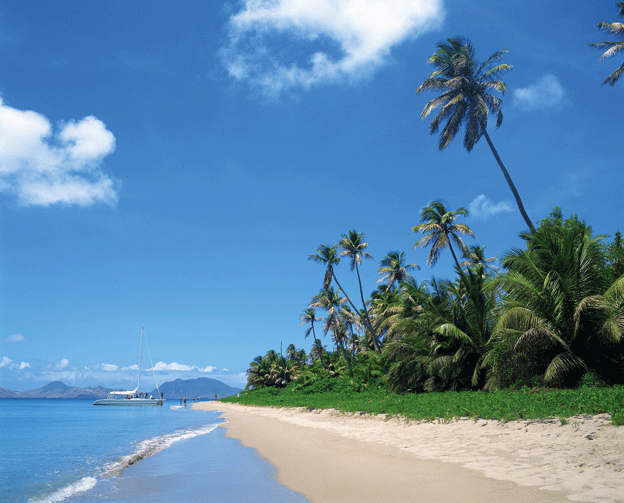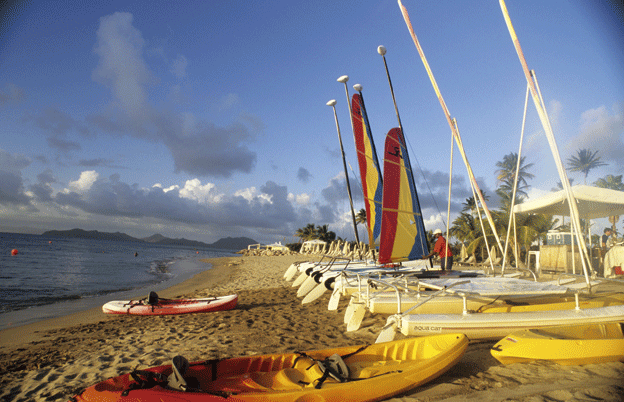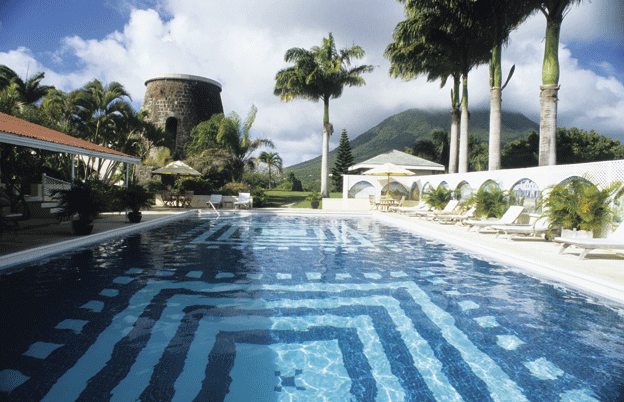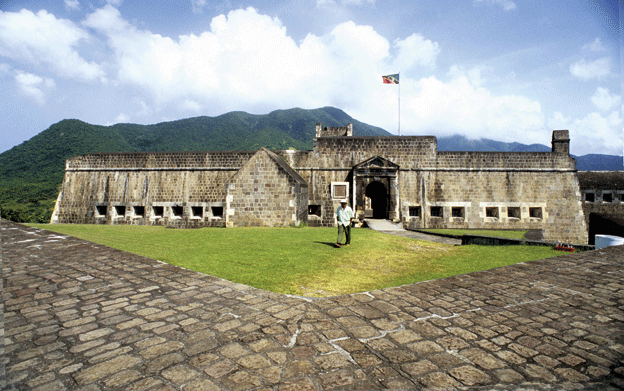
Travel
St. Kitts and Nevis
Pearls of the Caribbean
Like no other Caribbean island tiny St. Kitts and Nevis embody a lush tropical haven more usually associated with the South Pacific. Luxuriant vegetation, sunlight and sea air abound.
By: Veronica Maria Garbutt

At the core of St. Kitts stands the cloud-fringed peak of Mount Liamuga while on Nevis, the mountain rises into a cloud forest filled with green vervet monkeys and brilliantly coloured flowers.
Yet nature is only one of the attractions of these calm, relatively offbeat destinations. Historically St. Kitts and Nevis were the pearls of the British Caribbean. On St. Kitts stood the impregnable fortress of Brimstone Hill while Nevis grew rich from the sugar industry. The two-island federation lies in the northern part of the Leeward Islands some 19 degrees north of the equator.
St. Kitts is 23 miles long and 5 miles wide at its widest point, covering an area of 63 sq. miles. The population today stands at around the 35,000 mark. Basseterre, the capital, is among the Caribbean’s most captivating harbour towns, a place where no building may stand higher than a coconut palm. Most visitors however head directly to the beach resort area of Frigate Bay, spending their time in the southern area where the island’s main beaches are to be found. Throughout the island there is a strong West Indian culture and the place has not been swamped by international tourism. The history of St. Kitts goes back some 4000 years when the coastal areas were settled. The first inhabitants, the pre-ceramic Sibonay people were followed by Arawak Indians from what is today Venezuela.
Then the Caribs arrived followed by European settlers in the 17th century. Thomas Warner, an Englishman, came ashore in 1623 and became the first settler. Then the following year Pierre Belain d’Esnambue a French privateer, arrived. Soon the two men teamed up and divided the island, fighting off the Caribs who were none too pleased by this arrangement.
 After 200 years of rivalry between the British and the French, the British gained the upper hand by the early 19th century. When the denizens were not being besieged they were busy planting sugar cane. Despite its smaller size Nevis was the Leewards’ capital for a time, so prosperous that it was dubbed ‘Queen of the Caribees’. Independence came in 1983. Today, apart from a small income from agriculture, livestock farming, electronic assembly, data processing and garment manufacture, the Federation’s economy is based on a slowly expanding tourist industry.
After 200 years of rivalry between the British and the French, the British gained the upper hand by the early 19th century. When the denizens were not being besieged they were busy planting sugar cane. Despite its smaller size Nevis was the Leewards’ capital for a time, so prosperous that it was dubbed ‘Queen of the Caribees’. Independence came in 1983. Today, apart from a small income from agriculture, livestock farming, electronic assembly, data processing and garment manufacture, the Federation’s economy is based on a slowly expanding tourist industry.
We begin our Kittitian exploration in Basseterre, which, as the name suggests, was founded by the French. In 1727 the British adopted it in preference to their capital at Old Road. The Old Town is brimming with Georgian stone buildings with timber-frame upper storeys. Not far from the waterfront lies Circus, a meeting of roads modelled on London’s Piccadilly Circus. Here, an elaborate green Victorian clock tower stands encircled by stately royal palms. On Friday evenings it comes alive with people relaxing or ‘lining’ as the locals say.
The former centre of colonial Basseterre was Pall Mall Square, known since 1983 as Independence Square. Bordered by grand Georgian homes, it was once the site of the Lesser Antilles largest slave market. To the east is Port Zante, an area which has recently been redeveloped. An old warehouse on the waterfront has been converted into Pelican Mall together with an area for craft vendors. A new deep water cruise ship port has been built on reclaimed land along with a sailing and power boat marina. This is also the spot where the inter-island ferry Caribe Queen berths. And across the channel is a striking view of Nevis.
Most of the island’s beaches are of black, volcanic sand, but the main resort area, Frigate Bay, boasts white sand. On the calmer Caribbean side, known as Timothy Beach, there is a watersports shack with windsurfers, kayaks and snorkelling equipment for hire. St. Kitts Scuba and Pro-Divers offer single tank dives, two tank dives and night dives. What better opportunity to discover the area’s expansive reefs with corals, sponges, colourful fish along with some coral encrusted anchors from the 19th century.
Time now to head out and explore the island. Take a minibus from Basseterre going clockwise to Dieppe Bay Town. The circle-island road passes several petroglyps, a batik factory and the crumbling stacks of disused sugar mills. It is an enjoyable rural ride, with vistas of sugar cane, narrow gauge rail tracks with vintage trains and scattered villages of wooden houses with tin rooftops. Along the way, the journey is enlivened by booming reggae music and the chattiness of the local passengers.
A must stop along the way is Brimstone Hill Fortress National Park. The conical 800 ft fortress, built in 1690, was lovingly restored in the 1960s earning it UNESCO World Heritage Site status. As a major British garrison, Brimstone Hill played a major role in battles with the French. From the citadel, which is lined with some 24 cannons, there are fine coastal views while within a museum showcases cannonballs, swords, pottery and Amerindian artefacts. Most interesting of all, however, is a display of the West Indian role in the American revolution.
A few miles further on lies Rawlins Plantation, one of several plantation great houses dotted around the island.  This is a good place to stop for a lunch of salt fish and funchi (candied sweet potato) or lobster with mangoes on the veranda. After a dip in the pool to cool off you can visit the natural wonder of Black Rocks, an intriguing formation of lava that tumbles into the sea. Then it’s on to Ottey’s Plantation for tea before stopping at Nature’s Kingdom, a wildlife observatory, on the way back to Basseterre.
This is a good place to stop for a lunch of salt fish and funchi (candied sweet potato) or lobster with mangoes on the veranda. After a dip in the pool to cool off you can visit the natural wonder of Black Rocks, an intriguing formation of lava that tumbles into the sea. Then it’s on to Ottey’s Plantation for tea before stopping at Nature’s Kingdom, a wildlife observatory, on the way back to Basseterre.
And so on to Nevis which lies two miles across The Narrows Channel from St. Kitts. Columbus gave Nevis its present name, after Las Nieves, Spanish for snow, probably because the clouds shrouding the mountain reminded him of a snow-capped peak. Prior to this the locals called their island Oualie (Land of Beautiful Waters) smaller than St. Kitts, covering 36 square miles, this almost circular island is also quieter and is noted for its stunning Pinney’s Beach. And, for all its diminutive size, Nevis was once the capital of the Leewards.
Charlestown is the island’s capital and only town. A few streets of old stone radiate from Independence Square and Walwyn Square. Named in 1671 after England’s King Charles II, the town is home to around 2,000 locals. Beside the ferry dock along the waterfront lies Charlestown Market where fruits and spices are piled high upon the tables shortly after dawn. Adjacent old stone warehouses have been redeveloped to house modern businesses, a craft market, restaurants and colourful cafés.
Set in a pretty garden on Low Street is the Museum of Nevis History. Dating from the 1680s it was the birthplace of Alexander Hamilton, architect of the American Constitution. Inside is a fine chronological exhibition of artefacts from Amerindian times to the present day, with special sections on reef conservation and the rainforest.
Take the road south from Charlestown to the remains of Fort Worth, completed in 1790. A little further on lies the ruined Bath Hotel and Spring House. It sits over a thermal spring, thought to have therapeutic properties owing to its sulphur content. Nearby is the Horatio Nelson Museum which showcases the mariner’s life and times in the West Indies. It was built in 1992, to commemorate the 205th anniversary of the marriage of Admiral Nelson and Fanny Nisbet.
Slightly off the road to the south lies Montpelier Inn, venue of the Nelson-Nisbet wedding in 1787. In more recent times it hosted the late Princess Diana and is a great place for a pampering dinner on the veranda overlooking the spotlit gardens. In the vicinity are the Botanical Gardens, an oasis of flowering trees and shrubs with cacti, orchids and helicorias. A greenhouse modelled on London’s Kew Gardens, boasts ponds, bridges and a waterfall amid the tropical greenery. Here you can enjoy high tea while sitting in on nature.
 Three miles east lies Gingerland, centre of the island’s ginger root production as well as nutmeg and cinnamon. Known for the island’s largest number of sugar plantations the area is windy and atmospheric. Nearby at Fothergills lies the Nevisian Heritage Village where local social history is depicted through wooden buildings. Dating from the Carib Indian era, the houses are replicas and are furnished with period antiques and relics. Along with the dwellings are a blacksmith’s shop, shoemakers store and “backyard” gardens with banana trees and other indigenous plants.
Three miles east lies Gingerland, centre of the island’s ginger root production as well as nutmeg and cinnamon. Known for the island’s largest number of sugar plantations the area is windy and atmospheric. Nearby at Fothergills lies the Nevisian Heritage Village where local social history is depicted through wooden buildings. Dating from the Carib Indian era, the houses are replicas and are furnished with period antiques and relics. Along with the dwellings are a blacksmith’s shop, shoemakers store and “backyard” gardens with banana trees and other indigenous plants.
In the north lies the small fishing community of Newcastle. Here red clay is used to make traditional cooking pots. Nearby is Nisbet Beach, the island’s loveliest. But it is Pinney’s beach further south that is the place for watersports and equipment can be hired at the Four Seasons Hotel. Adjacent is a neat, well kept 18 hole golf course designed by Robert Trent Jones Jr. Other sporting possibilities include fishing, hiking, mountain biking and horseback riding at the Nevis Equestrian Centre.
The annual average temperature of the islands is 79°F and annual rainfall averages 55 inches. The driest months are February to June. Humidity is low and constant northeast tradewinds keep the Federation cool. So anytime is a good time to visit. If you want to catch the annual sailing regatta – local races between colourful fishing craft – time your visit for May. In June the Music Festival is held, featuring four days of calypso, reggae, soul, Latin and soca rhythms. Independence day on 19 September is celebrated with traditional Caribbean feasting and festivities. And a great time is had by all.